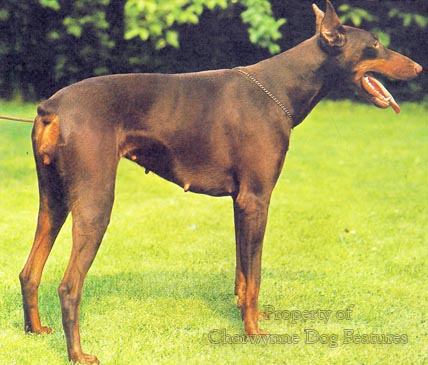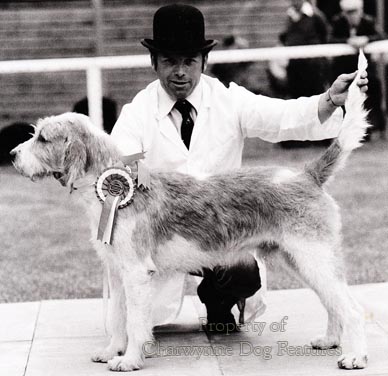620 Is pure-breeding working
IS PURE-BREEDING GOOD BREEDING?
by David Hancock
 If pure-bred means of unmixed descent then it can hardly be applied to our recognised breeds of dog, those registered as breeds by the Kennel Club. According to the KC's own Glossary of Terms, the words pure bred are defined as 'A dog whose sire and dam belong to the same breed, and are themselves of unmixed descent.' If the caveat 'for a minimum of five generations' had been added to this definition, it would have had greater validity. I would be interested to know of a recognised breed which is truly of unmixed descent. Such an event is as assailable as the statement that modern dog is descended from modern wolf, as so many lazily claim. But for a breed to come from mixed ancestry is for me a strength not a derogatory sly gibe. It is fair to state, I believe, that only show breeders rate purity of breeding ahead of the worthiness of the individual dog. To value a dog solely because it is a registered pure-bred dog and not mainly because of its mental and physical attributes is, to me, irrational and unwise.
If pure-bred means of unmixed descent then it can hardly be applied to our recognised breeds of dog, those registered as breeds by the Kennel Club. According to the KC's own Glossary of Terms, the words pure bred are defined as 'A dog whose sire and dam belong to the same breed, and are themselves of unmixed descent.' If the caveat 'for a minimum of five generations' had been added to this definition, it would have had greater validity. I would be interested to know of a recognised breed which is truly of unmixed descent. Such an event is as assailable as the statement that modern dog is descended from modern wolf, as so many lazily claim. But for a breed to come from mixed ancestry is for me a strength not a derogatory sly gibe. It is fair to state, I believe, that only show breeders rate purity of breeding ahead of the worthiness of the individual dog. To value a dog solely because it is a registered pure-bred dog and not mainly because of its mental and physical attributes is, to me, irrational and unwise.
Those who use dogs, sportsmen, hunters, shepherds and ranchers, demand dogs with ability. The hunting world both here and overseas has long sought field excellence ahead of any cosmetic value or respect for registries. The maintenance of a studbook has for them been important eugenistically not the dogmatic insistence on a closed gene-pool, come what may. Writing in Hounds magazine in 2004, Charles Fielding, an acknowledged expert on hound breeding, used these words: "Fortunately hounds are bred from in the winter when their working abilities are foremost in the mind, but woe betide anyone who tries to breed for looks alone." It is hard to imagine any breed registered with the KC following such a philosophy. Breed purity and cosmetic appeal has in so many breeds held sway over soundness, health, historic type and ability to fulfil the breed's original purpose.
It is strange that outcrossing to another breed either to restore type or improve the phenotype is considered an anathema by so many pure-bred dog devotees. The list of breeds improved or developed by such an outcross is already impressive: Foxhound blood in the Pointer, Greyhound blood in the Deerhound, Springer blood in the Field Spaniel, Tibetan Mastiff blood in the re-created Irish Wolfhound and the use by Millais of Bloodhound blood in his Basset Hound breeding plans, for example. Inspired breeders used selected breeds for the blend which produced the Dobermann, the Korthals Griffon, the Black Russian Terrier and the Dogo Argentino. The surreptitious use of Borzoi blood to change the shape of the Collie's head, of Wire-haired Fox Terrier blood in the Welsh Terrier and of Pug blood to change the jaw length of the Bulldog is rarely aired. The Mastiff was re-created here in the 19th century using the blood of the Tibetan Mastiff, the Great Dane and the Alpine Mastiff, but is still usually described as our 'ancient breed'. 
Despite that background the fierce defence of pure-breeding is the norm in Britain, but not in the hunting field, where performance is all and the conformation to achieve that performance studied assiduously. The blood of the West Country Harrier can be found in most Foxhound pedigrees here and in over forty packs in America. The blood of the Welsh Hound similarly appears in the extended pedigrees in so many packs here. The pursuit of excellence and the desire to improve field performance takes precedence over mere dogma it seems. The French hunting packs soon swooped to obtain the blood of the world-famous Dumfriesshire Foxhounds, when the hunting ban imposed by the Scottish parliament took effect. The Foxhound is recognised by the KC and now appears at KC-licensed shows. I cannot see the blood of Welsh Hounds or Harriers being used to improve the breed's show ring specimens if needed, whatever the hunting mens' views. This blending of blood is how all sporting breeds were shaped and handed down to us; is breeding wisdom going to the dogs!
In spite of the craving for pure unsullied blood, invented breeds like the Kromfohrlander, the Chinook, the Eurasier and the Kyi-Leo, the first-named from an accidental mating between two breeds kenneled together, are now recognised as breeds abroad. Where is the logic in such recognition? It makes the insistence on closed gene-pools look absurd. Of course crossing two breeds needlessly doesn't make sense, if necessary when the production of say a purpose-built lurcher is desired. But when cross-breeding improves a breed it should surely be welcomed; injudicious cross-breeding however without skilled advice and shrewdly-selected material should always be avoided. There are no magic answers in breeding, the selection of breeding stock based on diligent research is always the way forward. 
But the choice of breeding material should be based surely on need, not dogma. In recent years I have seen two 'Mastiffs' which conformed to the type depicted in so many 17th, 18th and early 19th century portrayals. One was a Mastiff-Staffie cross and the other a Mastiff-Bullmastiff cross. The Mastiff of the show ring is for me a fawn Alpine Mastiff, lacking the anatomy of our famous native breed. That may not be surprising, bearing in mind the blend of breeds behind the Mastiff's re-shaping in the 19th century, but is it historically correct? Once, at an Irish Wolfhound ring, I watched a shaggy exhibit for a while and then remembered where I had seen that 'look' previously - in the depiction of an early importation of a Tibetan Mastiff. Capt Graham, re-creator of the Irish Wolfhound used a Tibetan Mastiff sire 'Wolf' on the wolfhound 'Tara' and their offspring appear in the pedigree of every modern Irish Wolfhound.
It is always a risk when crossing two breeds or introducing outside blood into a breed that too much of one feature will crop up in time to the detriment of true breed type. A closed breed gene-pool is unlikely to provide redress. Only once have I detected this 'Tibetan Mastiff look' in an Irish Wolfhound, but I see the 'Alpine Mastiff look' in every contemporary Mastiff ring I view. The Mastiff of England was a hunting dog, a hound; the Alpine Mastiff was a mountain dog, requiring bulk and less athleticism. The mountain dog anatomy is now dominant and in my view true type has been lost in this famous native breed. But the breed fanciers seem happy with their stock, which is disappointing. The Mastiff is a feature of our canine heritage and should not be represented by an alien form. If this breed has been 're-created' once and that action condoned, why can't it be done again and with greater historical accuracy this time?